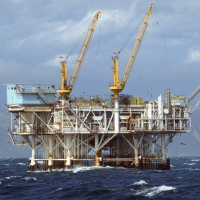Greens Take Fight over California Offshore Fracking to Federal Court
 Drilling off the coast of Santa Barbara (photo: Steve Malone, Associated Press)
Drilling off the coast of Santa Barbara (photo: Steve Malone, Associated Press)
Sixteen months after journalists revealed for the first time that oil companies were fracking in California coastal waters, one environmental group sued the federal government last week and another threatened to follow suit in two months if the feds don't tell the drillers to stop.
The Environmental Defense Center sued (pdf) the U.S. Department of the Interior, claiming the government violated federal laws when it approved well-stimulation drilling techniques in the Santa Barbara Channel without proper environmental review. The channel was the site of a devastating oil spill in 1969, often cited as an inspiration for the birth of the modern environmental movement.
The center wants the department's Bureau of Safety and Environmental Enforcement (BSEE) and Bureau of Ocean and Energy Management (BOEM) to conduct the environmental reviews and safety permit oversight that lawmakers intended when they created them in 2011 after the BP Deepwater Horizon disaster in the Gulf of Mexico the year before.
The lawsuit alleges that 51 applications to drill and make permit modifications for the purpose of using well stimulation were approved in the last 18 months without any public participation or adequate environmental review. The lawsuit claims that at least 15 of the 22 offshore platforms in the Santa Barbara Channel have used fracking (more formally known as hydraulic fracturing) during the last 20 years.
Many of the insights and arguments made in the lawsuit were echoed by the Center for Biological Diversity (CBD), which sent letters to all the government principals mentioned above that it will sue (pdf) the federal government in 60 days if nothing is done about the drilling.
“Fracking and other unconventional well stimulation are inherently dangerous practices that have no place in fragile ocean ecosystems,” the CBD said in its official notification of its intent to sue. Federal regulatory agencies are “rubber-stamping permits . . . with no analysis of the environmental impacts.” Those actions “violate a myriad of laws.”
Fracking, acidization and other methods involve the injection of pressurized water, sand and toxic chemicals into rock fractures to create passages for oil and gas to flow. The techniques have been around for decades but have been enhanced in recent years by technology and are responsible for a boom in U.S. domestic oil production.
The CBD said in its filing that the Interior Department's BSEE approved at least 20 fracking permits since 1996 and at least seven in the last five years. The center suspects the BSEE approved more but its records and those from the BOEM are so shoddy it is hard to tell.
For now, the center wants all well stimulation in the ocean to stop until Environmental Impact Statements (EIS) are completed as required by the National Environmental Protection Act (NEPA). They also want the federal government to involve state government in the process, as required by the Coastal Zone Management Act (CZMA).
The California Coastal Commission has never reviewed offshore well stimulation for consistency with California’s Coastal Management Program, the center said. “In fact, the Commission only became aware that fracking was occurring in federal waters off the coast of California in the summer of 2013, when journalists brought the situation to the public’s attention.”
State and federal governments have been reluctant to regulate fracking and other well- stimulation techniques despite a growing number of concerns about them. They have been linked to groundwater contamination, air pollution, releases of methane gas, micro-earthquakes and sinkholes.
California took its first step to regulate fracking et al in September 2013 when lawmakers passed Senate Bill 4. It allows fracking to continue unabated until 2015 while regulations are drafted. A mandated statewide environmental impact report on the practice isn’t due until July 2015. And while it does require frackers to reveal what toxic materials they are injecting into the ground, they can keep secret those details they consider trade secrets. Critics find the public notification provisions to be ineffectively weak.
–Ken Broder
To Learn More:
Greens Fight Fracking Offshore California (by Rebekah Kearn, Courthouse News Service)
Environmental Group Lawsuit Targets Offshore Fracking in California (by Rory Carroll, Reuters)
More Offshore Fracking Discovered in Southern California Waters (by Ken Broder, AllGov California)
Lawsuit Launched Against Offshore Fracking in California's Santa Barbara Channel (Center for Biological Diversity)
Environmental Defense Center v. Bureau of Safety and Environmental Enforcement et al (U.S. District Court for the Central District of California Western Division) (pdf)
- Top Stories
- Controversies
- Where is the Money Going?
- California and the Nation
- Appointments and Resignations
- Unusual News
- Latest News
- California Forbids U.S. Immigration Agents from Pretending to be Police
- California Lawmakers Urged to Strip “Self-Dealing” Tax Board of Its Duties
- Big Oil’s Grip on California
- Santa Cruz Police See Homeland Security Betrayal in Use of Gang Roundup as Cover for Immigration Raid
- Oil Companies Face Deadline to Stop Polluting California Groundwater





